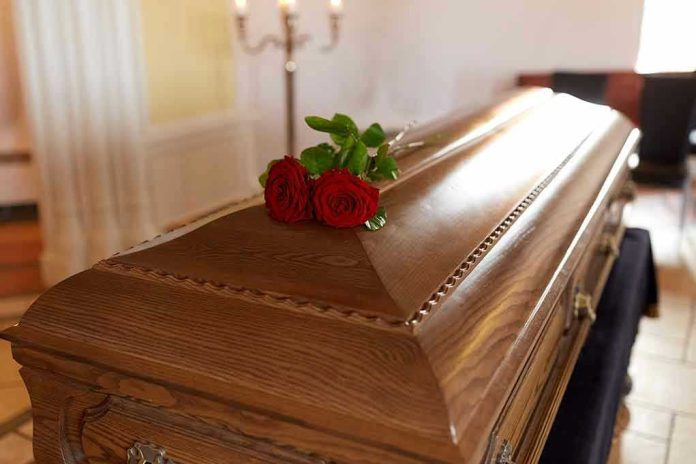
Mistaken for dead and nearly cremated, a Thai woman’s desperate knocking from inside her own coffin exposes a system where life and death can hinge on a single, unchecked assumption.
Story Snapshot
- A 65-year-old Thai woman, believed dead by her family, was found alive inside a coffin minutes before cremation.
- The family, lacking medical expertise, transported her 225 miles to a temple for a free funeral.
- Her survival highlights dangerous gaps in rural Thai healthcare and the absence of strict death verification protocols.
- The incident was recorded on video, sparking calls for policy reform on death certification.
Death’s Door Hinged on a Knock: The Scene Unfolds
Phitsanulok province, early morning, November 23, 2025—Chonthirot, a 65-year-old woman bedridden for years, is discovered unresponsive at home. Her family, convinced she has passed, does not call a doctor. Instead, they place her in a coffin and embark on a four-hour, 225-mile journey to a temple near Bangkok, seeking a cost-free cremation. The temple, known for its charity funerals, is the last stop for many impoverished families. As monks prepare the pyre, a faint, persistent knocking emerges from within the coffin. Relatives and temple workers open the lid, finding Chonthirot alive—shaking, disoriented, but unmistakably breathing. Her story, captured on video, instantly spreads across Thailand’s social networks.
Doctors soon reveal her “death” was a misdiagnosis; low blood sugar, not the end of life, had rendered her unresponsive. The result is a viral sensation, but also a jarring wake-up call for a nation where medical oversight is not a given.
When Rituals Replace Medical Protocols
In rural Thailand, traditions often fill the void left by limited healthcare. Families may handle the declaration of death themselves, especially when money or access to doctors is scarce. Temples become both spiritual sanctuaries and default mortuaries for the poor. This system, while compassionate, is rife with risk. Chonthirot’s family, acting from love and desperation, did what countless others have done: they assumed, without clinical verification, that silence and stillness meant death. The journey to the temple, intended to honor her in death, nearly became her grave. Only the unthinkable—a living knock from a presumed corpse—broke the cycle.
Such stories are not unique to Thailand. Across the globe, mistaken death declarations have led to chilling near-misses, but rarely are they so starkly documented or so deeply rooted in communal custom. The event lays bare the collision between tradition and the necessity for modern medical safeguards.
Ripples of Shock: Stakeholders, Trauma, and Relief
Chonthirot’s ordeal thrusts her family, particularly her brother Mongkol, into unwanted spotlight. Their relief at her survival is palpable, but so, too, is their trauma—haunted by the knowledge that love and error nearly became fatal companions. Temple staff, including the worker Thammanun who first heard the knocking, recount their shock: a routine cremation derailed by an impossible resurrection. After the incident, medical professionals finally take charge, diagnosing the true culprit—hypoglycemia, a danger often overlooked in chronic patients. Their involvement arrives late, a sobering lesson in the price of medical inattention.
Power in this story is diffused and fragile. The family, thrust into the role of decision-makers, act with the best intentions but limited tools. Temple workers, far from mere facilitators, become last-minute saviors. The absence of institutional oversight is the silent antagonist, shaping every decision and near-disaster.
Viral Outcry and the Urgent Call for Reform
The video of Chonthirot’s rescue ricochets through Thai media and social platforms, transforming a personal ordeal into a national debate. Public reaction oscillates between horror and incredulity; how could a woman nearly be cremated alive in 2025? Medical experts and funeral industry professionals swiftly weigh in, urging mandatory medical confirmation before cremation. Rural health scholars point to systemic issues: a chronic lack of trained personnel, inadequate outreach, and a cultural reliance on layperson assessments. The consensus is clear—this cannot be dismissed as a rare fluke. For families like Chonthirot’s, the line between life and death is thin, sometimes marked only by a faint knock.
As the story fades from viral sensation to case study, its implications remain. Calls grow for policy changes, particularly in rural areas, to ensure no family faces such a harrowing ordeal again. The funeral sector anticipates heightened scrutiny. Rural communities, shaken but resilient, begin to question practices long taken for granted. Chonthirot’s knock may have saved her life, but its echo could change a nation’s protocols for years to come.
Sources:
NDTV: Moments Before Cremation, ‘Dead’ Thai Woman Awakens Inside Coffin
Baku.ws: Woman came back to life in coffin minutes before cremation in Thailand







